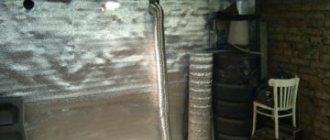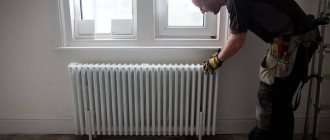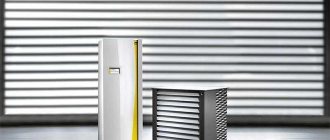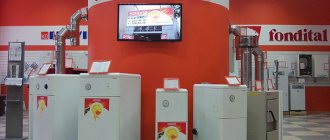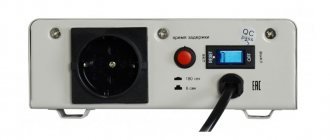SHARE ON SOCIAL NETWORKS
FacebookTwitterOkGoogle+PinterestVk
The issue of heating is more relevant in our area than anywhere else - the rather harsh climate forces us to think through home heating systems in the cold season. But when it comes to autonomous systems that do not require high costs and complex installation, many questions arise. Let's consider one of the most popular options - a catalytic gas heater: advantages, disadvantages, as well as features of use.
Catalytic gas heater in a country house, stylized as a wood-burning fireplace
Catalytic gas heater: operating principle of the device
Catalytic heaters appeared in our country relatively recently, but this has not stopped them from currently occupying a worthy position in the market. The principle of their operation is fundamentally different from those used in other gas appliances. In the standard scheme, fuel entering the burner undergoes combustion, resulting in the release of thermal energy.
Diagram of a catalytic gas heater
Among the disadvantages of this method of heat extraction is the fact that the process releases a large amount of combustion by-products. This negatively affects both the efficiency of the devices and the ratio of oxygen and carbon dioxide in the room. These disadvantages are unusual for catalytic heaters, since their operating principle is different.
The process of burning fuel in a catalytic gas heater does not involve the presence of a flame. Instead, the following processes occur:
- When the device is turned on, the surface of the catalyst begins to heat up. Depending on the selected mode, the temperature can range from 200 to 500 °C;
- at this time, the air-fuel mixture is prepared in a special chamber;
- liquefied gas is supplied to the heated catalyst plate, which, under the influence of all factors, burns without forming a flame.
Typically, the plate used in catalytic heaters is made of fiberglass with platinum powder added to it. This allows the device to be not only safe, but also environmentally friendly. In addition, the thermal efficiency of such a system is significantly higher than that of standard gas burners, which explains the popularity of these devices.
Operating principle of a catalytic gas heater
Principle of operation
So, first you should understand what gas heaters are and how they work.
All models have common constituent parts, namely:
- frame;
- heat exchanger;
- heater;
- burner.
These elements are found in all gas heaters - from budget to the most modern.
More expensive models add convenience features such as a thermostat or automatic shutoff.
There is one more common point for all models - they run on gas, natural or liquefied. Using the device, fuel is converted into heat. Such a heater can be connected to both main gas and bottled gas.
Types of catalytic heaters
Catalytic heaters may vary depending on the type of fuel used, as well as some operating features. Since the internal structure of the heater directly affects its performance characteristics, let’s consider the main groups of such devices:
- gas heaters are the most common, but far from the only option. It is based on the combustion process of a propane-butane mixture. This option is ideal for heating country houses or garages. The most powerful devices can easily heat entire construction sites or warehouses. The maximum power of devices on sale is 4900 W. And although the device does not emit harmful impurities and combustion products during operation, it is worth using such devices with special attention in rooms whose area is less than 20 m²;
- A gasoline catalytic heater is a device that has a built-in fuel tank in advance. It is connected to a catalytic cartridge, where gasoline vapor is supplied to undergo oxidation. Such models are modest in size, which makes them convenient to use while hiking, fishing or hunting;
A catalytic gas heater can look very organic in the interior
Helpful advice! For greater convenience, some models of portable catalytic heaters are additionally equipped with a hob. This makes cooking on the go more comfortable.
- heaters operating on dry fuel or industrial alcohol. These are small-sized models, which, like gasoline ones, are intended for use in field conditions. Their heat is only enough to cover minimal needs - such as heating food, water, drying clothes and keeping the inside of the tent warm. Such models are lightweight (about 1-1.5 kg) and small in size. Inside the structure there is always a special compartment in which a container with alcohol or, if necessary, a gas cylinder is installed.
In addition to the main types, there is one more - catalytic multifuel heaters. This type of device can operate on any available fuel - both liquid and gaseous. The power of such a device usually ranges from 500 to 1200 W.
Portable infrared catalytic heaters powered by gas fuel
Calculation of power by volume
This type of calculation is more accurate because it takes into account the height of the ceilings. The ratio that is taken when calculating the heat load is that to heat 1 m3 of the total volume of the room, 40 W of heat will be required.
Algorithm for determining power by room volume:
- Use a tape measure to measure the height, length and width of the room and determine the volume.
- Multiply the resulting value by 0.04 and get the recommended thermal power.
- Correction factors for insulation, glazing, and type of room are taken into account.
By performing the calculation, you can make sure that the efficiency and economy of heating largely depends on the level of insulation and glazing of the house, so the owner should be interested in carrying out insulation work and replacing double-glazed windows with energy-efficient ones.
Calculation of gas consumption
After determining the thermal power, they begin to calculate gas fuel for heating needs, on natural gas, they perform it according to the formula: L = Q / (qH x 0.90), where: L is the volumetric indicator of hourly gas consumption per 1 m3/hour; Q – design power of the convector, kW; Q ng – lower calorific value of natural gas, for main gas it is equal to 10.2 kW/m3; 0.95 – convector efficiency. For the above example, heating a house with an area of 150 m2 and a maximum thermal load of 15 kW, the calculation is:
15 / 10.2 x 0.95 = 1.54 m3 / h of natural gas.
Gas consumption per day is 1.54 x 24 = 36.96 m3, and
Monthly consumption – 36.96 x 30 = 1081 m3.
Infrared catalytic gas heater for a summer residence
Another parameter by which catalytic heaters are usually distinguished is the presence of an infrared emitter. Models with this addition have a targeted effect thanks to ceramic panels and reflectors located on the inner surface. Thus, thermal energy, converted into infrared radiation, enters the environment.
Such devices, as a rule, have extremely high performance and run on gas fuel. Their use is not limited to heating homes. You can often find such heaters on the street: they can be equipped with summer areas and verandas. Thanks to infrared radiation, devices do not waste energy on heating the surrounding air, but act on surrounding objects, heating them.
It is difficult to say clearly which gas heater is better: infrared or catalytic without a diffuser. In the second case, the device warms up the air, not objects, which is absolutely inappropriate if we are talking about installation outdoors. In any case, it is worth studying the issue of gas catalytic heaters more deeply: reviews of each model can easily be found online and the appropriate conclusions can be drawn.
Many models of catalytic heaters are ideal for travel use
Helpful advice! If you need to heat a large area, it is best to consider a heater with a fan heater. This addition will quickly increase the air temperature in the room.
Methodology for calculating the power and consumption of a gas convector
In order for the equipment to be effective, it must be correctly selected for the specific conditions of the heating facility. The consumption of a gas convector is not easy to achieve, since the work is based on complex thermal processes that depend on many factors: ambient temperature, heating area, ceiling height, heat losses, wall and roof material, number of windows and many other parameters. Experts have simplified the calculations and derived the dependence of the device’s power on the heating area. This is, of course, an approximate calculation and can be applicable for heating objects in central Russia and with a ceiling height of no higher than 2.5 m, however, many successfully use this ratio:
1 kW of power per 10 m2 of total area.
For the northern regions of the country, due to lower winter temperatures, a correction factor of =1.5 must be taken into account.
When calculating the flow rate of a gas convector, it is necessary to take into account correction factors
For example, to heat a 4-room house with a total area of 150 m2 in Voronezh, you will need 4 convectors with a capacity of: 150:10:4 = 3.5 kW per installation or 15 kW of total power.
You can make a more accurate calculation if you perform it for each individual room and taking into account the insulation level of the object.
Correction factors for power calculations:
- Without insulation – 1.1;
- single-layer windows – 0.9;
- corner room – 1.2;
- ceilings with a height of 2.8 to 3 m - 1.05.
Advantages and disadvantages of heating with a catalytic heater
Before you buy a catalytic heater, you need to understand all the advantages and disadvantages of this heating method.
Advantages of a catalytic heater:
- A catalytic heater for a summer house or home does not have a negative effect on the microclimate of the room. It does not disturb the natural balance of oxygen and carbon dioxide and does not emit harmful substances that are usually formed during the combustion process, thus maintaining a healthy microclimate;
Catalytic gas heaters are environmentally friendly and safe devices
- The device is much safer than traditional gas ones, since there is no danger of poisoning due to excessive carbon monoxide release. In addition, there is no risk of fire. Such a device can be used without fear in a home, a tent, or an industrial workshop;
- Another important advantage is the ability to regulate the power of the device. This allows you not only to maintain a comfortable temperature, but also to save significantly;
- mobility – even large and powerful devices can be moved quite easily, not to mention compact heaters. According to device owners in reviews, catalytic heaters often easily fit into a bag or backpack.
Despite the abundance of significant advantages, catalytic heaters are not without disadvantages:
- such devices have a fairly limited operating period - about 2500 hours. The fact is that during use the catalyst gradually burns out and after a certain time it needs to be changed. The amount is approximately 2/3 of the cost of exactly the same new equipment, so it’s easier to throw away the old device and buy a new one;
With small dimensions, a portable catalytic heater can easily heat a small room or tent
- The quality and life of a catalytic heater directly depend on how well purified fuel you use. Low-quality gasoline or technical alcohol will very quickly render the device unusable.
Choosing a country heater
Let's start by clarifying the concept of “dacha”. Some call a dacha a small summer house where you can relax and store gardening tools, others mean a country mansion. We do not consider the second case; it requires a full-fledged heating system - water or air.
Now let's move on to recommendations on how to choose a gas heater:
- If in winter you visit a country house infrequently and without an overnight stay, it is easier and cheaper to buy a portable ceramic stove with a 5-liter propane tank. This is convenient: the stove is easy to transport and can be used in other places - a garage, a workshop.
- If you stay for a longer period, you should take care of your health and purchase a catalytic combustion stove; it emits much less harmful emissions.
- For permanent residence, definitely choose a convector. If the house is gasified, you can heat it constantly. In terms of reliability, the device is equal to a gas boiler and is quite capable of operating safely without human intervention.
- A convector installed in the central room can best cope with heating 2-3 rooms. Leave interior doors open.
- You arrived at your dacha, started the boiler, but the temperature in the house is rising slowly. A simple ceramic heater will help quickly heat up a living room.
On the left in the photo we see the back of a gas stove with a small cylinder, on the right there is a defect in the ceramic panel (the material crumbles and crumbles).
Gun heaters are of little use for heating a dacha. Unless you want to quickly heat up a cold terrace or greenhouse. The heater consumes a lot of propane and emits the same amount of harmful exhaust, and an indirect heating gun will be too expensive.
Important. Of all types of gas heating systems, only a convector, and even a fireplace, is suitable for heating residential buildings. Conscientious manufacturers of infrared burners indicate in the instructions that the device is intended for heating utility, technical and utility rooms.
Catalytic heater for the garden and home: safety of use
If you are thinking about whether to buy a catalytic heater for your cottage or home, the most important selection criterion will probably be the safe operation of the device.
There is a misconception that catalytic gas heaters can be unsafe and can put the life and health of users at risk. In fact, this is not true. Of course, as with any other device, with a catalytic heater it is necessary to follow safety rules that are designed to reduce potential risks to a minimum.
Long-wave infrared radiation not only does not harm human health, but can also have a positive effect
As for the effect of this heater on the human body, we can say with confidence the following: carbon monoxide is not formed as a result of the oxidation process and, accordingly, does not accumulate in the room. This means there is no risk of poisoning. In the case of using infrared radiation, only long waves are used, which are not only not harmful, but even useful.
Note! It has been repeatedly confirmed that long-wave infrared radiation has a positive effect on both the nervous and immune systems of humans, having a beneficial effect on overall health.
Manufacturers
Gas heating convectors are becoming more and more popular. And all because they heat up really quickly, are quickly installed, and even the heating is not too expensive. Therefore, new and new manufacturers are constantly appearing on the market. But buying equipment from unknown companies is a big risk. There are many proven ones. If we talk about those that belong to the category of “infrared gas fireplace” (on wheels), BARTOLINI has the best reviews. They are beyond competition. Even despite the fact that the price of its closest competitors - REMINGTON - is two times lower. But no one complained about Bartolini. The equipment always turns out to be up to par and no one has ever regretted the purchase. All other brands are slightly worse in quality.
Also have good reviews:
- MASTER (China, but not bad)
- REMINGTON
- Ballu
- Timberk
- Alpine Air
- Prorab
- Aesto
- Neoclima.
All of the listed companies produce good equipment, but there is also a very long list of unknown ones that may be much lower, but the characteristics are the same. What is typical is that they can produce the same parameters. But alas, miracles do not happen. Usually, after a couple of seasons, a ceramic stove burns out. It begins to crumble and crumble. Accordingly, in this place the burner does not ignite, but gas flows! If no one notices this, the gas will fill the room... And the undamaged part of the burner is burning. What's next is clear. That’s why it’s better not to experiment and buy proven equipment. The most reliable one is made in Europe. If "what happens", known. So there is no doubt about the safety of their products.
There are devices that do not require either a stationary heating system or coolant to operate. Their use is convenient in any conditions, even in the absence of any communications. Gas infrared heaters from a cylinder operate using a supply of propane. And although this method of heating a room cannot be called the safest, it is quite popular among a wide range of users. Let's try to figure out why.
Gas infrared heater does not require connection to communication systems
The most popular brands and models of catalytic gas heaters
There are not many companies on the heating equipment market that offer truly high-quality products. Therefore, when choosing the option that suits you, you should pay attention to reputable manufacturers. Let's try to figure out which companies' devices are the most popular, and also consider the features of some models from these manufacturers.
The ability to regulate the power of the device allows you to maintain a comfortable temperature in the room, as well as save money
Gas catalytic heaters Bartolini
Heating equipment from the famous Italian brand Bartolini is very popular in Russia. Producing fairly powerful devices (from 2900 to 4200 W), this company has provided heat to many homes. The manufacturer placed the main emphasis on the complete independence of the devices from the presence of any communications. All models run on liquefied gas.
Popular Bartolini catalytic gas heaters:
| Model name | Characteristics | Dimensions, weight | price, rub. |
| Bartolini pullover k turbo plus |
| 780x430x420 mm 13.5 kg | 15750 |
| Bartolini pullover k |
| 780x430x420 mm 13.5 kg | 11480 |
| Bartolini pullover i |
| 780x430x420 mm 13.5 kg | 13200 |
| Bartolini primavera k |
| 780x430x420 mm 13.5 kg | 11480 |
The most popular among the presented models is the gas catalytic heater Bartolini pullover k. Reviews about it are very positive, and the cost of this device is one of the most affordable. At the same time, if you need to heat a room whose area exceeds the standard 35 m² for these devices, you can purchase Bartolini pullover i. It has great power and can easily heat about 50 m².
In the production of heating equipment, Bartolini focuses on the complete independence of the devices from the presence of any communications
Which gas catalytic heater to choose: Bartolini pullover k, Bartolini pullover i or any other of the proposed options should be decided based on personal preferences and operating conditions of the room that is supposed to be heated. In any case, there is no doubt about the quality and reliability of the devices from this manufacturer.
Heating equipment from Campingaz company
The second most popular place is confidently occupied by Campingaz. For more than 60 years, this French company has been producing all kinds of equipment, mainly gas equipment. The company focuses on providing the most comfortable stay in nature at any time of the year. And an excellent example of this is the Campingaz cr 5000 turbo gas catalytic heater.
The maximum power of this heater is 3000 W, and the device is equipped with a power regulator and piezo ignition. The device is quite economical - when used at maximum power, fuel consumption is no more than 0.2 kg/h.
When choosing catalytic gas equipment, it is important to consider under what conditions it will be used
Gas catalytic heaters Kovea
The Korean company Kovea closes the top three among foreign manufacturers whose gas heaters are popular today. This company is ready to offer its customers a wide variety of models, as well as, as a supplement to them, special purified fuel.
Table with characteristics of the three best Kovea heater models:
| Model name | Characteristics | Dimensions, weight | price, rub. |
| Kovea KH-2006 |
| 25x24x23 cm in a package of 1.4 kg | 6460 |
| Kovea KH-0203 |
| 34x28x19 cm per package; 2.1 kg | 10130 |
| H-0710 Fire Ball |
| 190x180x190 mm 565 g | 6233 |
Gas catalytic heater Argo
If you want to purchase an even more budget-friendly heater, you should pay attention to the domestically produced Argo gas catalytic heater. This device is widely used for heating verandas, garages, and industrial premises where there is a fairly high level of air circulation. This appliance should not be used in small or confined spaces.
Most often, the Argo heater is used when it is necessary to maintain a high temperature in a greenhouse or barn where animals are kept. Many farmers use it to grow their products.
Portable catalytic gas heaters are popular among fishermen, as well as lovers of various types of outdoor activities.
The device also runs on liquefied gas, which enters it from a cylinder through a special hose. The volume of the connected cylinder can be from 5 to 15 liters. With a power of 2900 W, the device consumes only 0.25 kg/h of gas, burning it on a panel heated to 800-900 °C. At the same time, the percentage of carbon dioxide released does not exceed 0.01%. Nevertheless, as mentioned above, it is not recommended to use this heater in poorly ventilated areas.
The device is small in size but significant in weight. With dimensions of 420x330x210 mm, its weight is 6.7 kg, which makes it difficult to move over significant distances. However, for stationary use the Argo heater is a completely suitable option. Moreover, you can purchase such a model for only 2100 rubles.
What it is
This is a specialized device that provides a comfortable temperature in the room. It is highly efficient - the efficiency of infrared gas heaters reaches 80%.
Externally, IR gas ceramic devices look very respectable - they can be made in different configurations or sizes. The operating principle of heaters allows you to change the shape of the working element without loss of performance.
There are powerful models designed for heating large production areas. There are also compact household appliances designed for use at home. These types of devices are used to heat a dacha.
They are highly efficient and economical, allowing you to create a comfortable temperature in the room in the shortest time periods.
Principle of operation
Infrared heaters have a specific operating principle.
They radiate thermal energy into space, and all surfaces and objects in the radiation zone interact with this radiation. This means that it is not the air that is heated, as happens with convector-type devices, but the objects placed in the room.
A clear example of such an effect is the Sun - it heats the surface of the Earth, and the air is heated by it.
The device of a gas IR heater includes the following elements:
- mixing chamber where gas is combined with air;
- ceramic plates with holes through which the air-gas mixture passes. It burns and heats the plates to 800-900 °C;
- a reflector that reflects radiated heat waves in a certain direction.
Only the main structural components are listed. Many manufacturers are constantly developing and making their own amendments to the design, which makes the devices more efficient and economical.
Varieties
Ceramic gas heaters are available in different modifications, used in certain conditions.
The range of specialized stores includes:
outdoor heater
camp stove
converter
heat gun
fireplace
tiles, etc.
Only the most common design options are listed. It must be taken into account that all heaters are designed to implement the same basic tasks. Their names refer to configuration features rather than functional features.
Manufacturers are constantly developing new models and designs, expanding their range and producing devices with increased functionality.
For example, some models, in addition to heating rooms, can be used for cooking.
How to choose and buy a catalytic gas heater
The purchase of any device, including a catalytic heater, requires attention. You need to be as precise as possible: where, under what conditions and how often you plan to use the acquisition. When choosing, it is important to consider both the price of a gas catalytic heater and reviews of real customers about this model.
Many models of catalytic heaters are convenient to take on a hike or trip due to their small size and light weight
The parameters specified by the manufacturer will help you determine the required power of the device. The packaging usually indicates the maximum area the heater can cover.
Gas catalytic cylinder heaters have appeared on the market quite recently. However, their ease of use, as well as a high level of safety and environmental friendliness, quickly made them popular not only among outdoor enthusiasts, but also among those who simply want to efficiently heat their country house or garage. Such devices are highly efficient, affordable and are excellent for use in almost any conditions.
Types and forms
There are many types of gas infrared heaters. There are very simple, inexpensive, with little power. They are more suitable for camping life, for temporary use or as an option during emergencies. There are more “civilized” ones that do not spoil the interior. They have more security systems, but the operating principle remains the same.
Different types of gas infrared heaters and their prices
Based on their area of use, they can be divided into several groups:
- for street use;
- for premises.
Indoor units are distinguished by the presence of a larger number of sensors that monitor the air condition and the performance of the unit. Also, room heaters have automatic controls, with which you can regulate the temperature. Street cars usually have more power. There are gas infrared heaters for industrial premises - their power can be even greater than that of street ones.
Outdoor options for gas infrared heaters can have different shapes
By installation method you can find the following:
- nozzle for a gas cylinder;
- mobile (portable);
- ceiling;
- gas infrared fireplaces.
Of all, infrared gas fireplaces have the most “civilized” look. This is a fairly large case that can accommodate a standard 27 liter gas cylinder. The total mass of the units is quite substantial, so for ease of movement they are equipped with wheels.
The most civilized of infrared gas heaters
The cheapest ones are a nozzle for a cylinder, a little more expensive are camping ones, which are a small metal case with a ceramic heater. There are hiking options that connect to a cylinder, and there are options that are combined with fuel containers. In any case, these are very inexpensive installations.
Mobile infrared gas installations
Ceiling options are more often used for industrial premises, heating greenhouses, warehouses, etc. They are used extremely rarely in everyday life, since it is not very convenient to run a gas pipeline to this heater. Hidden installation is impossible, and pipes in residential premises are only appropriate in a loft style.
Ceiling - the best infrared gas heaters for a warehouse
If we talk about temporary heating of rooms, you can use any mobile model. If they are needed as constant heating or will be used frequently, it is better to choose models with air analyzers, flame control and other protective systems. These are more expensive models, but they guarantee safety.
Advantages and disadvantages
Among the obvious advantages that modern ceramic heaters have, several points can be highlighted.
High security. Even when heated to 900 degrees, ceramic elements do not emit hazardous or harmful substances. The material is completely natural, hypoallergenic, and does not affect the health of the respiratory system.
Efficiency up to 99%. The high heat transfer characteristic of all electric heaters is complemented by infrared radiation, which provides additional heating. In the case of gas devices, all these advantages are preserved.
Long service life of the heat exchange element. The ceramics inside the heaters or made in the form of plates for placement on the wall are not subject to corrosion and can be used for decades without loss of thermal conductivity properties.
High speed and uniform heating of the room
This is especially important for facilities where ceramic heaters become the only alternative to a traditional stove - in expedition trailers, country houses, and recreation centers.
Reduced energy consumption. Both gas and electric ceramic heaters require less energy than their classic counterparts with metal coils and heating elements.
They save not only energy resources, but also money that they have to pay on bills.
Compact dimensions and minimal weight. You can choose a model with floor, wall, or ceiling placement. They will be easy to use even in small-sized housing.
High level of fire safety. The presence of built-in tip-over protection, which instantly turns off the power supply, eliminates accidental fires. In addition, the front panel heats up to no more than +65 degrees Celsius; in case of accidental contact, the risk of burns is completely eliminated.
Complete absence of noise. The exception is models with a fan heater, but they also operate quite quietly.
Modern appearance. Ceramic panels and heaters look stylish and go well with different interior designs


